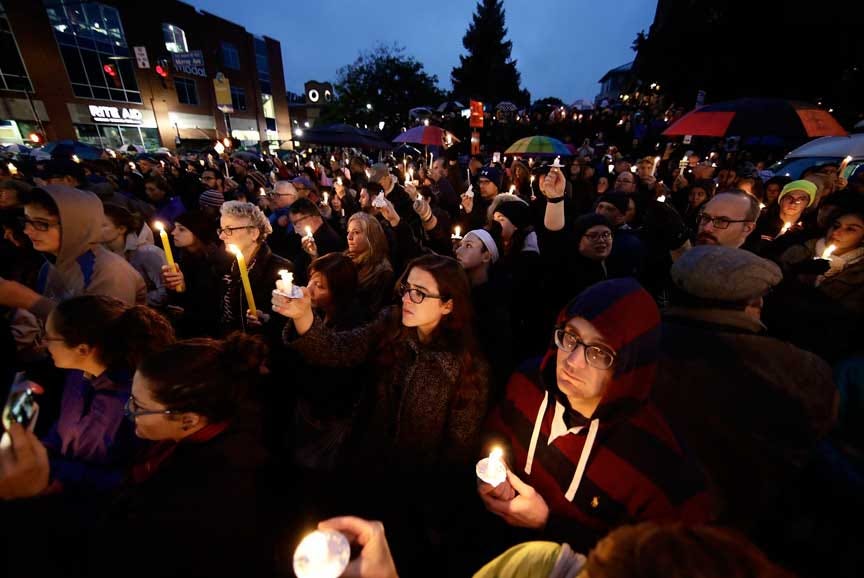DAY 13 OF THE GAZA WAR:US Intercepts Missiles Aimed at Israel, Rising Antisemitism in US
Tel Aviv Diary October 19, 2023
Today, Hamas launched noticeably fewer rockets at Israel. There were 14 hours of quiet — until approximately 1 PM, when initial missiles of the day targeted areas near Gaza. Later in the afternoon, missiles aimed at the Tel Aviv area were launched and subsequently intercepted. Contrary to their earlier tactics in the conflict, Hamas has been launching one or two rockets at a time (instead of larger salvos), making interception more manageable. The last missile targeting Tel Aviv was launched at 11 PM.
There was an uptick in attacks in the North today. Over twenty Hezbollah rockets targeted the North. Additionally, Hezbollah launched several anti-tank missiles at Manara and other sites. Today, for one of the first time in this escalation, rockets targeted the Western Galilee, Rosh Hanikra, Shlomi, and Naharia. All these rockets were either intercepted or landed in open areas.
In the late afternoon, Hamas directed rockets towards Kiryat Shmoneh, two rockets landed in the town, injuring one woman severely and lightly wounding two others — including a five-year-old child. In response, Israel retaliated against the source of the attacks.
Tonight, the Houthis in Yemen fired missiles towards Israel. The US naval destroyer, DDG-64 USS Carney, intercepted three land attack cruise missiles and several drones en route to Israel. The Houthis are Shiites who have been in conflict with Yemen’s Sunni government for the past decade. Iran supports the Houthis, providing them with both financing and weapons
.
The most tragic incident of the day occurred in a refugee camp in Tulkarem. A Border Police unit entered the camp to apprehend a suspect when an IED detonated, killing a policeman and injuring 11 others. The unit faced subsequent gunfire, but an armed IDF UAV was deployed, neutralizing four attackers and facilitating the unit's extraction.
Egypt announced that trucks carrying humanitarian aid will be dispatched into Gaza tomorrow morning.
The IDF provided an update on the number of abducted individuals. According to military sources, Hamas and its allies have taken 203 hostages, including 30 children and 10 elderly individuals. In addition, the whereabouts of between 100 and 200 people remain unknown. The military is uncertain about the current status of these missing individuals and the hostages, including whether they are alive or deceased.
British Prime Minister Rishi Sunak visited Israel today. Upon his arrival, the Prime Minister said, “I'm here to express my solidarity with the Israeli people. You have suffered an unspeakable, horrific act of terrorism and I want you to know that the United Kingdom, and I, stand with you.
”
The United States announced today that the program to allow Israelis to visit the US without a visa that was to become effective at the end of the year has become effective as of midnight today.
Antisemitism in America
I have several Israeli friends who, in recent days, have been asking me about the explosive surge of antisemitic events in the United States. The reports of incidents on numerous campuses, whether instigated by professors or student groups, and the celebration of the reprehensible actions of Hamas have shocked many in Israel, along with countless Jews in America. Tonight, I discovered that Hillel is employing armed guards to safeguard Jewish students attending Shabbat events across the US.
Some Context
Antisemitism in America is not a new phenomenon. Jews faced challenges from the outset when they arrived in the New World. The first group of Jews landed in New Amsterdam from Recife, Brazil, in 1654. The Dutch governor of the colony, Peter Stuyvesant, opposed their arrival. However, the Dutch West India Company's management overruled him. During the Civil War, a notable act of antisemitism took place on December 12, 1862, when Ulysses S. Grant, the Union troops' commander in Tennessee, issued General Order No. 11. This order accused the Jews of Tennessee of smuggling and mandated their expulsion from his territory. When President Lincoln became aware of this, he promptly revoked the order.
Post-Civil War, as Jews progressed in society, many believed they had achieved general acceptance. This perception was disrupted in 1877 when Joseph Seligman, a distinguished Jew of his era, was refused a reservation at a Saratoga hotel. The hotel manager openly declared that “No Israelite shall be permitted in the future to stop at this hotel." This episode marked the onset of various establishments excluding Jews. In response, Jews founded alternative establishments, often surpassing the original ones in quality.
Antisemitism manifested in various ways. In 1915, a group linked to the Klan lynched Leo Frank, a Jewish factory manager, after a governor's intervention saved him from an unjust execution for the alleged murder of a white factory worker. This lynching led nearly half of Georgia's 3,000-strong Jewish community to leave.
Around the same period, America's leading universities, which had adopted ability-based admission policies, noticed a growing number of Jewish students. They discreetly imposed a quota on Jewish admissions, which persisted until the 1960s.
With the mass immigration of Jews, in the early 20th century, there were numerous attempts to curtail that immigration. Opponents of Jewish immigration achieved their goal with the passage of the Immigration Acts of 1921 and 1924. These acts significantly limited immigration and effectively halted Jewish immigration.
In the interwar period, a new strain of antisemitism emerged, characterized by attacks on the so-called "globalist Jew." Henry Ford, a prominent figure of that era, became an outspoken antisemite. Using his newspaper, The Dearborn Express, he serialized the notorious "Protocols of the Elders of Zion." During the Depression, Charles Coughlin, a Catholic priest, reached an audience of 30 million with his weekly radio broadcasts. Coughlin often blamed "Jewish bankers" for society’s woes. A 1939 Roper survey indicated that 51% of respondents held unfavorable views of Jews. It's worth noting the widespread antisemitism when considering why FDR might have been hesitant to aid Jews before World War II.
Following World War II and the establishment of the State of Israel, antisemitic sentiments in the U.S. significantly decreased. However, discrimination against Jews persisted. For instance, until the mid-1960s Jews could only reside downtown in Greenwich, Connecticut above businesses, rather than in the main residential areas. Over time, these barriers began to dissipate.
The 1960s saw the rise of two distinct forms of antisemitism: Black antisemitism and left-wing antisemitism. Historically, Jews and African Americans had been allies. Yet, the rise of the Black Power Movement in the 1960s introduced tensions. Many businesses in African American neighborhoods were Jewish-owned, leading to significant friction. Stokely Carmichael of the Student Non-Violent Coordinating Committee (SNCC) once remarked, "It was the exploitation by Jewish landlords and merchants which first created black resentment towards Jews, not Judaism.” Post-Six Day War, the left began to align more with the Palestinian cause.
The years following the Six Day War can be considered a prosperous period for American Jewry, as they experienced increased wealth and influence. Yet, the 21st century saw a resurgence of antisemitism, evidenced by armed attacks on Jewish targets. In 2009, a white supremacist fatally shot a security guard at the National Holocaust Museum. In 2014, another white supremacist attacked Jewish institutions in Overland Park, Kansas, resulting in three casualties.
Disturbingly, underlying trends of antisemitism have become more pronounced. The extreme left has adopted age-old anti-Semitic narratives. Events like the second intifada in Israel and the U.S. invasion of Iraq radicalized the left. On the right, some argue that President Barack Obama's election, and the subsequent rise of the Tea Party, reflect an unwillingness by some to accept a Black president. Fringe elements within these groups have clung to old conspiracy theories, such as Jewish control of global banking.
Donald J. Trump, during his presidential campaign, resonated with some of the far right's deepest fears. Although not personally antisemitic, Trump’s rhetoric rekindled deep-rooted prejudices against Jews. His 2016 campaign's closing ad spotlighted notable figures, including three of Jewish descent: Financier George Soros, Federal Reserve Chair Janet Yellen, and Goldman-Sachs CEO Lloyd Blankfein.
On October 27th, 2018, a fervent white nationalist attacked the Tree of Life synagogue in Pittsburgh, killing eleven congregants.
Today, while the far-left perceives Jews as part of the white elite, the left has adopted a position that the weaker side is alway correct. Thus, they support the Palestinians, because they are the weaker side and therefore, deserve to be supported. The left has developed the concept of “Intersectionality,” a concept that describes how various forms of oppression, such as racism, sexism, and classism, intersect and overlap, affecting individuals in multiple and layered ways— and the Palestinians are part of that. The term “Intersectionality” emphasizes the idea that social justice movements should recognize and address all interconnected forms of oppression to be truly inclusive and effective.
At the same, the far right views Jews as outsiders and as outsiders the enemy. Theories have been advanced how the Jews are financing the replacement of white Americans. Billionaire George Soros has become the target of countless campaigns and accusations that have nothing to do with him. Rich Jews seems to be the target to both left and right.
Thankfully, in the U.S., these view are not mainstream either on the right or the left. However, they are significant enough to exert a disproportionate influence on public opinion.







Beyond the factors you detailed so astutely, US colleges/universities have been facing widespread threats to academic freedom, heavily but not exclusively from Christian nationalist factions, and to my eye faculty many seem to have seized upon this conflict to make a stand.